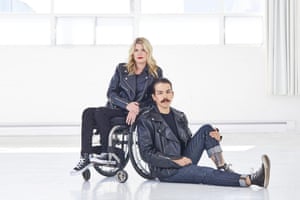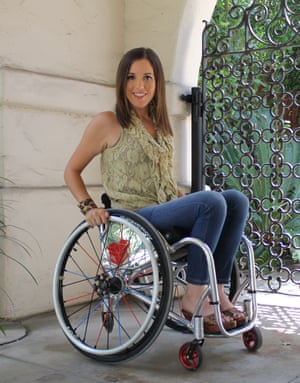Toronto-based designer Izzy Camilleri is best known for her work styling celebrities such as David Bowie, Angelina Jolie and Meryl Streep. But her latest collection, released this month, has one major difference: it is designed for people with disabilities.
After doing some custom work in the early 2000s for a client who was quadriplegic, Camilleri had her “eyes opened” to how existing clothing did not necessarily work for women using a wheelchair. For example, having a “seated frame” meant that many traditionally designed trousers rode down or dug into her client’s waist. At the time, “adaptive clothing” – clothes made with disabled people in mind – barely existed; when it did, it was not aimed at fashion-conscious young adults. “Most of what was out there were clothes for [older people] living in long-term care facilities,” Camilleri says. “I realised there was nothing for younger people. [I was] motivated to fill this void.”
In fact, Camilleri became so passionate about it that, in 2009, she released the revolutionary IZ collection, one of the world’s first fashion lines created for wheelchair users. Trousers do not ride down at the back or push on the wearer’s waist. Coats are cut so the customer can put them on while seated; they cover the thighs at the front, but reach only the seat of a person’s chair at the back, in order to avoid bunching.
Camilleri’s new range, IZ Adaptive, goes beyond the needs of wheelchair users to cater for those with a variety of disabilities. Trousers now come with horizontal pull-tabs at the side, waist and centre of the back, through which wearers with dexterity problems can slip their fingers to help them pull up the trousers without having to grip. They have elastic waists, too, negating the need for zips. Coats in the range have magnetic fastenings and pull-tabs on zippers.

Instead of being sold only through Camilleri’s website, as with her previous adaptive ranges, IZ Adaptive will be stocked by Zappos, the Amazon-owned global retailer, while her online store will ship worldwide from this autumn. The 55-piece launch collection is available at a “more accessible price point” than Camilleri’s previous range – from $25 (£19) for a T-shirt to $425 for a men’s suit.
Camilleri is tapping into a widespread predicament. I have loved fashion since I was a teenager, but I soon realised this did not sit well with being a wheelchair user. Over the years, I have spent a fortune altering skirts and dresses that sit too long or too short. I cannot buy standard jeans, as the zip and buttons cut in to my waist. The most recent government audit, in 2014, said disabled access on the UK high street, from entrances to changing rooms, was “shocking” – but at least the issue is discussed. Accessibility to the clothes themselves is rarely mentioned.
Stephanie Thomas, a consultant in Los Angeles and the creator of Cur8able.com, a fashion lifestyle blog about dressing with disabilities, is conscious of this contradiction. “In the US, we have the Americans with Disabilities Act, which means we have beautiful adapted, wheelchair-accessible changing rooms … and no clothing on the floor for people with seated body types,” she says. “Every time I go in to a store you can hear me mumbling. Ramps? Dressing rooms? But no clothing?”

But mainstream brands are slowly coming round. In April, Tommy Hilfiger launched its second full collection of adaptive clothing, following a line for children with disabilities in 2016 and an expanded range that also served adults in 2017. The Tommy Adaptive spring 2018 collection, which features colour-blocking, stripes and the signature red-white-and-blue palette, is fronted by models including the Paralympic gold medallist Jeremy Campbell, who has a prosthetic leg, and the dancer and wheelchair user Chelsie Hill. It features innovations such as magnetic buttons, adjustable hems (to open larger at the leg), easy-open necklines, adjustable waists and one-handed zips. Already available in the US, the range will go on sale to UK shoppers in 2019. “Tommy Adaptive’s mission is to be inclusive and empower people of all abilities to express themselves through fashion,” a company spokesperson said.
In many ways, this is an obvious development for an industry always looking for new ground to cover. Walk into any high street store and there will be clothing for specific consumers, be it maternity, plus size or petite. There is no reason ranges for disability should not be next. Such a move would not be a “worthy cause”, but rather smart economics. After all, disabled customers are far from a niche market: nearly one in five people in England and Wales have a disability, with a similar proportion reported in the US, and disabled people are the fastest-growing minority group in the world, according to the United Nations. The “purple pound” – the spending power of disabled people – is thought to be worth about £249bn to the UK economy alone.
Thomas says this is one reason why companies have an incentive to work to understand their customers with disabilities and to get the tone right when pitching to them. “Everyone wants to wear their favourite brand. People don’t want to wear a brand that says ‘I’m super-different from you’ in a negative way,” she says.
The progress that we are starting to see is long overdue. As Thomas, a congenital amputee, put it in her excellent TEDx talk on adaptive clothing in 2016: “We have more clothing in stores for dogs than we do for people with disabilities”. With Tommy Hilfiger rare among mainstream brands in selling adaptive clothing, the market is populated by independent, small-scale companies: Netherlands-based Chairmelotte offers “wheelchair couture”, while the US firm Abl Denim provides denim suited to disabled people, from lightweight denim with high waists, to avoid “downward slipping” for wheelchair users, to reverse waistbands for people with sensory-processing disorder. There is also variation across countries; while North America and parts of Europe appear to be making gains, the UK is arguably slipping behind.

Emma McClelland, from Manchester, hopes to change that. In December, the 30-year-old quit her job as an editorial manager at a law firm to launch Kintsugi Clothing, a fashion line designed with the aim of being “fashionable, accessible and inclusive”. It is a labour of love for McClelland – the project is self-funded by her savings and freelance work and she is selling her house to invest in the development of the range. It was Thomas’s TEDx talk that inspired her to look into the adaptive clothing market. “I was surprised to find that it’s mainly beige, bland and ugly,” she says. “The more I read … the more I see how people with impairments are sidelined, even from things as simple as fashion.”
She pointed to existing British adaptive ranges, such as Adaptawear and Able2Wear, which are aimed at older people and carers, rather than independent young adults and fashion-minded older customers.
Having researched clothing with occupational health therapists and her local para sports teams, McClelland is now working with a manufacturer to develop samples to test on disabled users. The range will include a magnet-and-Velcro-fastening shirt and two-piece dresses and jumpsuits for wheelchair users, as well as skirts with hidden pouches for catheter bags and support belts for ileostomy bags.

That adaptive clothing is slowly becoming a viable market says a lot about fashion’s changing relationship with disability – that it is moving past the idea that disability is not aspirational enough for fashion and that it is the one area of diversity that can still be excluded (the much-praised May cover of British Vogue – pegged as celebrating “diversity across the board” – featured no disabled models). But more than that it addresses popular culture’s wider assumptions of what it is to be disabled.
Last month, a study by the disability charity Scope found that as many as one in eight members of the public hardly ever or never think of disabled people “as the same as everyone else”. Thomas believes the slow progress in “disability fashion” is an “oversight” that stems from this way of thinking, rather than a conscious bid to exclude disabled customers. As she points out, disabled people – often judged as “ugly freaks”, asexual or even institutionalised – have not historically been integrated into society and it is only recently that this has begun to change. The fashion industry, like any part of society, is slowly catching up. “You can’t serve someone that you don’t value and you can’t value people you don’t see,” says Thomas. “If people don’t see someone with disabilities as a fashion customer, their needs won’t be considered or met. We have to change the perception around disability. We have to change the conversation.”
Perhaps the rise in adaptive clothing is a pivotal part of this conversation, one that begins to understand that just because someone’s needs may be different does not mean their interests are.